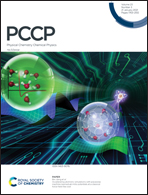Perfluoro effect on the electronic excited states of para-benzoquinone revealed by experiment and theory
Abstract
We report a comprehensive study on the electronic excited states of tetrafluoro-1,4-benzoquinone, through high-resolution vacuum ultraviolet photoabsorption spectroscopy and time-dependent density functional theory calculations performed within the nuclear ensemble approach. Absolute cross section values were experimentally determined in the 3.8–10.8 eV energy range. The present experimental results represent the highest resolution data yet reported for this molecule and reveal previously unresolved spectral structures. The interpretation of the results was made in close comparison with the available data for para-benzoquinone [Jones et al., J. Chem. Phys., 2017, 146, 184303]. While the dominant absorption features for both molecules arise from analogous π* ← π transitions, some remarkable differences have been identified. The perfluoro effect manifests in different ways: shifts in band positions and cross sections, appearance of features associated with excitations to σCF* orbitals, and spectrum broadening by quenching of either vibrational or Rydberg progressions. The level of agreement between experiment and theory is very satisfactory, yet that required the inclusion of nuclear quantum effects in the calculations. We have also discussed the role of temperature on the absorption spectrum, as well as the involvement of core-excited resonances in promoting dissociative electron attachment reactions in the 3–5 eV range.



 Please wait while we load your content...
Please wait while we load your content...